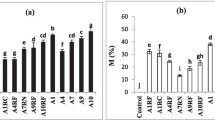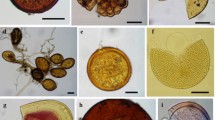Abstract.
Arbuscular mycorrhizal (AM) fungi in coalmine spoil, island forest and saline soils were enriched in pot culture with maize (Zea mays L.), tobacco (Nicotiana tabacum L.), white clover (Trifolium repens Linn.) and silverweed cinquefoil (Potentilla anserina L.). Based on spores, there were more species of AM fungi in the coalmine spoil (15 species, 3 genera), than in the forest soil (11 species, 4 genera) and the saline soil (5 species, 2 genera). In the trap cultures, the total of 28 species in Acaulospora, Gigaspora, Glomus, and Sclerocystis detected in the original soils were all recovered with at least one of the four trap plants. The highest spore and species numbers were recovered in trap cultures of T. repens inoculated with coalmine spoil. Glomus constrictum and Glomus multicaule were the dominant species associated with N. tabacum grown in saline soil and forest soil. The dominant species of AM fungi on the four hosts was Acaulospora mellea, which had over 90% of the spore incidence in pot trap culture in coalmine spoil. It is suggested that there be selectivity between host plants and AM fungi. The number of species of AM fungi detected was influenced by host plants under certain conditions and white clover was generally the optimal host plant to detect diversity of AM fungi.
Similar content being viewed by others
References
Al-Raddad AM (1993) Distribution of different Glomus species in rainfed areas in Jordan. Dirasat-Series B Pure Appl Sci 20:165–182
An Z-Q, Hendrix JW, Hershman DE, Henson GT (1990) Evaluation of the "most probable number (MPN)"and wet-sieving methods for determining soil-borne populations of endogonaceous mycorrhizal fungi. Mycologia 82:576–581
Bever JD, Morton JB, Antonovics J, Schultz PA (1996) Host-dependent sporulation and species diversity of arbuscular mycorrhizal fungi in a mown grassland. J Ecol 84:71–82
Biermann B, Linderman RG (1981) Quantifying vesicular arbuscular mycorrhizae: a proposed method towards standardization. New Phytol 87:63–67
Brundrett MC(1991) Mycorrhizas in natural ecosystems. In: Macfayden A, Begon M, Fitter AH (eds) Advances in ecological research, vol 21. Academic Press, London, pp 171–313
Brundrett MC, Bougher N, Dell B, Grove T, Malajczuk N (1996) Working with mycorrhizas in forestry and agriculture. ACIAR Monograph 32. Australian Centre for International Agricultural Research, Canberra
Brundrett MC, Abbott LK, Jasper DA (1999a) Glomalean mycorrhizal fungi from tropical Australia I. Comparison of the effectiveness and specificity of different isolation procedures. Mycorrhiza 8:305–314
Brundrett MC, Jasper DA, Ashwath N (1999b) Glomalean mycorrhizal fungi from tropical Australia II. The effect of nutrient levels and host species on the isolation of fungi. Mycorrhiza 8:315–321
Cuenca G, Meneses E (1996) Diversity patterns of arbuscular mycorrhizal fungi associated with cacao in Venezuela. Plant Soil 183:315–322
Douds DD Jr, Schenck NC (1990) Relationship of colonization and sporulation by VA mycorrhizal fungi to plant nutrient and carbohydrate contents. New Phytol 116:621–627
Franke-Snyder M, Douds DD Jr, Galvez L, Phillips JG, Wagoner P, Drinkwater L, Morton B (2001) Diversity of communities of arbuscular mycorrhizal (AM) fungi present in conventional versus low-input agricultural sites in eastern Pennsylvania, USA. Appl Soil Ecol 16:35–48
Gazey C, Abbott LK, Robson AD (1992) The rate of development of mycorrhizas affects the onset of sporulation and production of external hyphae by two species of Acaulospora. Mycol Res 96:643–650
Genney DR, Hartley SH, Alexander IJ (2001) Arbuscular mycorrhizal colonization increases with host density in a heathland community. New Phytol 152:355–363
Helgason T, Daniell TJ, Husband R, Fitter AH, Young JPW (1998) Ploughing up the wood-wide web? Nature 394:431
Hendrix JW, Guo BZ, An ZQ (1995) Divergence of mycorrhizal fungal communities in crop production systems. Plant Soil 170:131–140
Hetrick BAD, Bloom J (1986) The influence of host plant on production ability of vesicular-arbuscular mycorrhizal spores. Mycologia 78:32–36
Johnson NC, Tilman D, Wedin D (1992) Plant and soil controls on mycorrhizal fungal communities. Ecology 73:2034–2042
Kaushal S (2000) Influence of edaphic factors on VAMF spore population and root colonization in Acacia nilotica in Rajasthan. J Mycol Plant Pathol 30:386–388
Liu RJ, Li XL (2000) Arbuscular mycorrhiza and application (in Chinese). Science Press, Beijing, pp 1–224
Loth FG (1997) Abundance of arbuscular mycorrhizal fungi spores at different native sites as affected by sewage sludge applications (in German). Bodenkultur 47:89–96
McGonigle TP, Fitter AH (1990) Ecological specificity of vesicular-arbuscular mycorrhizal associations. Mycol Res 94:120–122
Menge JA (1984) Inoculum production. In: Powell CL, Bagyaraj DJ (eds) VA mycorrhiza. CRC Press, Boca Raton, Fla., pp 187–203
Menge JA, Steirle DJ, Bagyaraj DJ, Johnson ELV, Leonard RT (1978) Phosphorus concentration in plants responsible for inhibition of mycorrhizal infection. New Phytol 80:575–578
Montanes VJ, Monge LE (1997) Influence of different soil conditions and nitrogen application on arbuscular mycorrhizas with apple trees. Acta Hortic 448:119–124
Morton JB, Bentivenga SP, Wheeler WW (1993) Germplasm in the international collection of vesicular-arbuscular mycorrhizal fungi (INVAM) and procedures for culture development, documentation and storage. Mycotaxon 48:491–528
Morton JB, Bentivenga SP, Bever JD (1995) Discovery measurement and interpretation of diversity in arbuscular endomycorrhizal fungi (Glomales, Zygomycetes). Can J Bot 73:25–32
Schenck NC, Kinloch RA (1980) Incidence of mycorrhizal fungi on six field crops in monoculture on a newly cleared woodland site. Mycologia 72:445–456
Schenck NC, Perez Y (1988) Manual for identification of vesicular arbuscular mycorrhizal fungi, 2nd edn. INVAM. University of Florida, Gainesville, Fla.
Sieverding E (1989) Ecology of VAM fungi in tropical agrosystems. Agric Ecosyst Environ 29:369–390
Smith SE, Read DJ (1997) Mycorrhizal symbiosis, 2nd edn. Academic Press, London
Stutz JC, Morton JB (1996) Successive pot cultures reveal high species richness of arbuscular mycorrhizal fungi in arid ecosystems. Can J Bot 74:1883–1889
Thomson BD, Roberson AD, Abbott LK (1992) The effect of long-term application of phosphorus fertilizer on populations of vesicular-arbuscular mycorrhizal fungi in pastures. Aust J Agric Res 43:1131–1142
Van der Heijden MGA, Klironomos JN, Ursic M, Moutoglis P, Streitwolf-Engel R, Boller T, Wiemken A, Sanders IR (1998) Mycorrhizal fungal diversity determines plant biodiversity, ecosystem variability and productivity. Nature 396:69–72
Wang FY, Liu RJ (2001) A preliminary survey of arbuscular mycorrhizal fungi in saline-alkaline soil of Yellow River Delta (in Chinese). Biodivers Sci 9:389–392
Watson DMH, Milner PD (1996) Assessment of glomalean species biodiversity as influenced by trapping methods. In: Szaro TM, Bruns TD (eds) Programs and Abstracts of the First International Conference on Mycorrhizae. University of California, Berkeley, Calif., p 125
Zhao ZW, Xia YM, Qin XZ, Li XW, Cheng LZ, Sha T, Wang GH (2001) Arbuscular mycorrhizal status of plants and the spore density of arbuscular mycorrhizal fungi in the tropical rainforest of Xishuangbanna, Southwest China. Mycorrhiza 11:159–162
Acknowledgements.
The authors are very grateful to Professor Bernie Dell in the School of Biology, Murdoch University, and Professor Lyn Abbott in the School of Earth and Geographical Sciences, The University of Western Australia, for suggesting revisions to the manuscript. This research was supported by National Natural Science Foundation of China (No.30170622).
Author information
Authors and Affiliations
Corresponding author
Rights and permissions
About this article
Cite this article
Liu, R., Wang, F. Selection of appropriate host plants used in trap culture of arbuscular mycorrhizal fungi. Mycorrhiza 13, 123–127 (2003). https://doi.org/10.1007/s00572-002-0207-4
Received:
Accepted:
Published:
Issue Date:
DOI: https://doi.org/10.1007/s00572-002-0207-4




